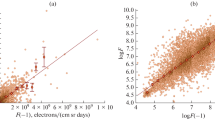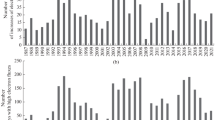Abstract
The variation of the flux of energetic electrons in the magnetosphere has been proven to be strongly related to the solar wind speed. Observations of GEO orbit show that the flux of low-energy electrons is not only modulated by the solar wind speed, but, if a time delay is added, is also positively correlated to the flux of high-energy electrons. This feature provides a possible method to forecast the flux of high-energy electrons in GEO orbit. In this study, the correlations of the fluxes between the high-energy electrons and low-middle-energy electrons obtained at different L values and in different orbits are investigated to develop the application of this feature. Based on the analysis of long–term data observed by NOAA POES and GOES, the correlations between the fluxes of high-energy electrons and low–middle–energy electrons are good enough at different L values and in different orbits in quiet time, but this correlation is strongly affected by CME–driven geomagnetic storms.
Similar content being viewed by others
References
Zong Q G, Zhou X Z, Wang Y F, et al. Energetic electron response to ULF waves induced by interplanetary shocks in the outer radiation belt. J Geophys Res, 2009, 114: A10204
Claudepierre S G, Elkington S R, Wiltberger M. Solar wind driving of magnetospheric ULF waves: Pulsations driven by velocity shear at the magnetopause. J Geophys Res, 2008, 113: A05218
Zong Q G, Wang Y F, Yuan C J, et al. Fast acceleration of “Killer” electrons and energetic ions by interplanetary shock stimulated ULF waves in the inner magnetosphere. Chin Sci Bull, 2011, 56: doi: 10.1007/s11434–010–4308–8
Yan Q, Shi L Q, Liu S Q. Effect of seed electron injection on chorus- driven acceleration of radiation belt electrons. Sci China Tech Sci, 2013, 56: 492–498
Ding Y H, He Z G, Zhang Z L, et al. Influence of wave normal angle on gyroresonance between chorus waves and outer radiation belt electrons. Sci China Tech Sci, 2013, 56: 2681–2689
Wang D D, Yuan Z G, Deng X H, et al. Compression-related EMIC waves drive relativistic electron precipitation. Sci China Tech Sci, 2014, 57: 2418–2425
Selesnick R S, Blake J B, Kolasinski W A, et al. A quiescent state of 3 to 8 MeV radiation belt electrons. Geophys Res Lett, 1997, 24: 1343–1346
Li X L, Temerin M, Baker D N, et al. Quantitative prediction of radiation belt electrons at geostationary orbit based on solar wind measurements. Geophys Res Lett, 2001, 28: 1887–1890
Barker B, Li X, Selesnick R S. Modeling the radiation belt electrons with radial diffusion driven by the solar wind. Space Weather, 2005, 3: S10003, doi:10.1029/2004SW000118
Drew L, Turner W, Li X L. Quantitative forecast of relativistic electron flux at geosynchronous orbit based on low-energy electron flux. Space Weather, 2005, 6: S05005
Lam, H L. On the prediction of relativistic electron fluence based on its relationship with geomagnetic activity over a solar cycle. J Atmos Sol-Terr Phy, 2004, 66: 1703–1714
Nagai T. “Space weather forecast”: Prediction of relativistic electron intensity at synchronous orbit. Geophys Res Lett, 1988, 15: 425–428
Paulikas G A, Blake J B. Effects of the solar wind on magnetospheric dynamics: Energetic electrons at the synchronous orbit, quantitative modeling of magnetospheric processes 21. Geophys Monograph Series, 1979, 79: 180–202
Li X L, Baker D N, Temerin M, et al. Energetic electrons, 50 keV to 6 MeV, at geosynchronous orbit: Their responses to solar wind variations. Space Weather, 2005, 3: S04001
Lam M M, Horne R B, Meredith N P, et al. Moffat-Griffin T and Green J C, Origin of energetic electron precipitation >30 keV into the atmosphere. J Geophys Res, 2010, 115: A00F08
Geoffrey D. Reeves, relativistic electrons and magnetic storms: 1992–1995. Geophys Res Lett, 1998, 25: 1817
Dmitriev A V, Chao J K, Dependence of geosynchronous relativistic electron enhancements on geomagnetic parameters. J Geophys Res, 2014, 108: 1388
Reeves G D, McAdams K L, Friedel R H W, et al. Acceleration and loss of relativistic electrons during geomagnetic storms. Geophys Res Lett, 2003, 30: 1529
Denton M H, Borovsky J E, Skoug R M, et al. Geomagnetic storms driven by ICME- and CIR-dominated solar wind. J Geophys Res, 2006, 111, doi: 10.1029/2005JA011436
Le G, Russell C T, Gosling J T, et al. ISEE observations of low latitude boundary layer for northward interplanetary magnetic field: implications for cusp reconnection. J Geophys Res, 1996, 101: 27239–27249
Paschmann G, Sonnerup BUÖ, Papamastorakis I, et al. Plasma acceleration at the Earth’s magnetopause: evidence for reconnection. Nature, 1979, 282: 243–246
Hasegawa H, Fujimoto M, Phan T D, et al. Transport of solar wind into Earth’s magnetosphere through rolled-up Kelvin-Helmholtz vortices. Nature, 2004, 430: 755–758
Friedel, R H W, Reeves G D, Obara T. Relativistic electron dynamics in the inner magnetosphere: A review. J Atmos Sol-Terr Phy, 2002, 64: 265–282
Rodger, C J, Clilverd M A, Green J C, et al. Use of POES SEM-2 observations to examine radiation belt dynamics and energetic electron precipitation into the atmosphere. J Geophys Res, 115, 2010, A04202
Zou H, Luo L, Li C F, et al. Angular response of ‘pin-hole’ imaging structure measured by collimated source. Sci China Tech Sci, 2013, 56: 2675–2680
Luo L, Zou H, Zong Q G, et al. Anti–proton contamination design of the imaging energetic electron spectrometer based on Geant4 simulation. Sci China Tech Sci, 2015, 58: doi: 10.1007/s11431–015–5863–7
Author information
Authors and Affiliations
Corresponding author
Rights and permissions
About this article
Cite this article
Li, C., Zou, H., Zong, Q. et al. An analysis of the correlation between the fluxes of high-energy electrons and low-middle-energy electrons in the magnetosphere. Sci. China Technol. Sci. 59, 1130–1136 (2016). https://doi.org/10.1007/s11431-016-6029-y
Received:
Accepted:
Published:
Issue Date:
DOI: https://doi.org/10.1007/s11431-016-6029-y




